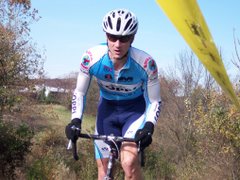There's an interesting article in this month's Road magazine by Hunter Allen on the power demands of cyclocross. (Sorry, I couldn't find an online link to the article). He quite correctly observes that 'cross is all about "microbursts" of high power followed by very short recoveries -- you're either hard on the gas or coasting. He recommends a couple of specific workouts, including one absolutely brutal workout he calls "30 Cubed." It's 30 seconds ON at 150% of FTP, 30 seconds OFF, and 30 seconds running for 10 minutes, rest and repeat. I guess you'd do it on a big grass field or a short circuit. Maybe incorporate a barrier into the "run" portion. If you can survive an hour of that workout, even incorporating recovery between sets, you'll be ready for 'cross season.
Dave Harris, endurance racer extraordinaire, has some profound insights from his 7 years of power data. A couple of observations struck home for me. First, years of endurance training will generate a pretty strong base. If you've been riding and competing for years, there really is no need to build a "base" of long, slow distance mileage in the winter. Unless you missed time due to an injury, you already have a significant base. Even in the winter, therefore, the emphasis should be on quality rather than quantity.
The second observation is that you need to leave some "headroom" above your chronic training load (CTL) to allow for training adaptation. Because the cyclocross season involves racing nearly every weekend, your CTL will drop throughout the season. My plan for next year is to build my CTL to a really high level by when the season starts. But it may be necessary to leave some "headroom" in the CTL for cross-specific training adaptation. Moreover, I suspect that the makeup of the CTL in the months leading into 'cross season is important. I came into this season with a relatively high CTL, but most of it came from long group rides and centuries (such as the Bridge to Bridge Challenge). As a result, I had great endurance, but not much "snap" in my first races. It took a few weeks of doing 'cross specific workouts before I started to come around. Next year I'll need to incorporate some more cross-specific work into my build up for 'cross, such as specific VO2max-level efforts and micro-intervals.
Dave Harris, endurance racer extraordinaire, has some profound insights from his 7 years of power data. A couple of observations struck home for me. First, years of endurance training will generate a pretty strong base. If you've been riding and competing for years, there really is no need to build a "base" of long, slow distance mileage in the winter. Unless you missed time due to an injury, you already have a significant base. Even in the winter, therefore, the emphasis should be on quality rather than quantity.
The second observation is that you need to leave some "headroom" above your chronic training load (CTL) to allow for training adaptation. Because the cyclocross season involves racing nearly every weekend, your CTL will drop throughout the season. My plan for next year is to build my CTL to a really high level by when the season starts. But it may be necessary to leave some "headroom" in the CTL for cross-specific training adaptation. Moreover, I suspect that the makeup of the CTL in the months leading into 'cross season is important. I came into this season with a relatively high CTL, but most of it came from long group rides and centuries (such as the Bridge to Bridge Challenge). As a result, I had great endurance, but not much "snap" in my first races. It took a few weeks of doing 'cross specific workouts before I started to come around. Next year I'll need to incorporate some more cross-specific work into my build up for 'cross, such as specific VO2max-level efforts and micro-intervals.
 The attached PMC chart shows that I already have solid base, as represented by the blue area. My CTL (dark blue line) is not at the highest point of the season, especially since I've essentially been "de-training" throughout the 'cross season, but it is high relative to last winter and to when I was injured at the end of May. Bottom line? I have a good base, no I need to concentrate on enhancing the areas that need it most for the upcoming road season.
The attached PMC chart shows that I already have solid base, as represented by the blue area. My CTL (dark blue line) is not at the highest point of the season, especially since I've essentially been "de-training" throughout the 'cross season, but it is high relative to last winter and to when I was injured at the end of May. Bottom line? I have a good base, no I need to concentrate on enhancing the areas that need it most for the upcoming road season.



